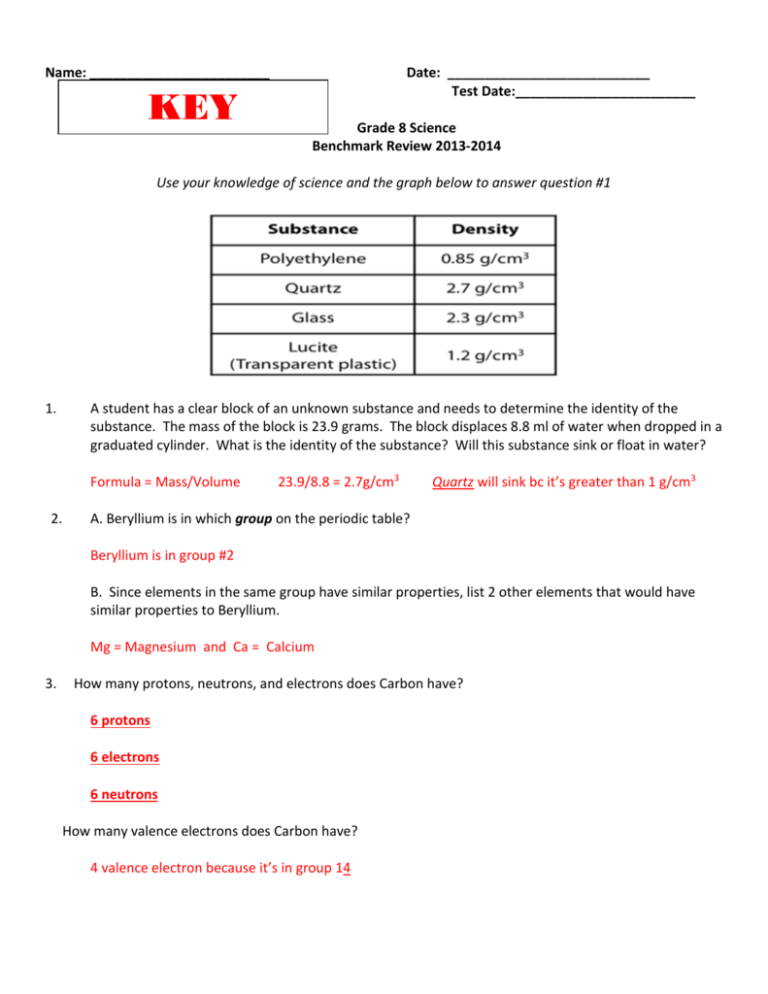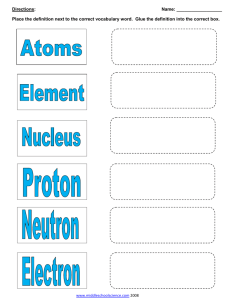Name:
advertisement

Name: ________________________ KEY Date: ___________________________ Test Date:________________________ Grade 8 Science Benchmark Review 2013-2014 Use your knowledge of science and the graph below to answer question #1 1. A student has a clear block of an unknown substance and needs to determine the identity of the substance. The mass of the block is 23.9 grams. The block displaces 8.8 ml of water when dropped in a graduated cylinder. What is the identity of the substance? Will this substance sink or float in water? Formula = Mass/Volume 2. 23.9/8.8 = 2.7g/cm3 Quartz will sink bc it’s greater than 1 g/cm3 A. Beryllium is in which group on the periodic table? Beryllium is in group #2 B. Since elements in the same group have similar properties, list 2 other elements that would have similar properties to Beryllium. Mg = Magnesium and Ca = Calcium 3. How many protons, neutrons, and electrons does Carbon have? 6 protons 6 electrons 6 neutrons How many valence electrons does Carbon have? 4 valence electron because it’s in group 14 4. How many protons, neutrons, and electrons does Sodium have? 11 protons 11 electrons 12 neutrons 5. A. What are the names, charges, and locations of the three subatomic particles we discussed? Proton = positive, located in the nucleus, Electron = negative, located outside the nucleus on the electron cloud, and Neutron = no charge (neutral), located in the nucleus B. Where are the valence electrons located? The valence electrons are located on the outermost shell 6. If an atom has eight electrons in its outermost shell, it is said to be stable (stable or reactive). 7. In a neutral atom, the number of protons is always equals to the number of electrons. 8. Draw a Bohr atomic model for Oxygen. (Label the nucleus as well as the protons, neutrons, and electrons; place the sub-atomic particles in the accurate locations on the model.) 8P 8N 9. An atom contains protons, neutrons, and electrons. Rank these subatomic particles from smallest to largest. Electrons (less than 1 amu), protron and neutrons (about 1 amu) 10. List the subatomic particles that are responsible for comprising the atom’s atomic mass? The atomic mass is made up of protons (+) and neutrons (0) 11. Which group of elements on the periodic table has one valence electron and is extremely reactive? Group #1 (alkali metals) 12. What group of elements is not reactive? Group #18 (noble gases) Why do they not react? Their outer energy level is complete (full with 8 electrons) 13. When conducting a laboratory involving heat, chemicals, or glassware, what safety precautions must you take? Wear gloves, wear goggles, tie your hair back, make sure you do not wear long hanging shirts/sleeves, wash your hands after handling the chemicals, wait for instructions from the teacher, dispose of chemical as instructed by your teacher, if you break glass inform the teacher 1 st, dispose of broken glass as instructed by your teacher, clean all glassware and lab materials before you are dismissed. 14. Draw H3PO4. HHHPOOOO 15. How many total atoms are in H2SO4? There are 2 hydrogen atoms, 1 sulfur atom, and 4 oxygen atoms 16. Which of the following is not a compound? (Circle one) H2SO4 H2O S3 HS3 17. What is the chemical formula if N = $, H = @, and O = #? @$### = HNO3 18. Using the symbols provided in the key, draw the following chemical reaction. Zn + 2HCl ZnCl2 + H2 KEY Zn H Cl + + 19. Is the following equation balanced or unbalanced? C3H8 Reactants C=3 H=8 O=2 Products C=3 H=8 O=10 + O2 Unbalanced 3CO2 + 4H2O 20. Is the following equation balanced or unbalanced? Zn Reactants Zn=1 H=2 Cl=2 Products Zn=1 H=2 Cl=2 + 2HCl ZnCl2 + H2 Balanced 21. When balancing equations, why do both sides of the arrow have to have the same number of atoms? a. The Law of Conservation of Mass b. The Law of Conservation of Energy 22. In Mrs. Smith’s science class, students added sodium (Na) to water (H2O) to see what would happen. They found that sodium hydroxide (NaOH) and hydrogen gas (H2) were produced. a. What are the reactants that the students used? Na, and H2O b. What are the products? NaOH and H2 c. Write out the chemical equation that best describes this reaction. Na + H2O NaOH + H2 23. Balance the following equations: 2Fe + 3H2SO4 → ____ Fe2(SO4)3 + 3 H2 3 KOH + ____ H3PO4 → ____ K3PO4 + 3H2O 2 BF3 + 3 Li2SO3 → ____ B2(SO3)3 + 6 LiF 4(NH4)3PO4 + 3 Pb(NO3)4 → ____ Pb3(PO4)4 +12 NH4NO3 24. Describe ionic bonding. Give an example of an ionic compound. In ionic bonding, the atoms are bound by attraction of opposite ions by nonmetals and metals. Example: Describe covalent bonding. Give an example of a covalent compound. Covalent bonding occurs when pairs of electrons are shared by atoms. Example: 25. Draw the electron dot configuration for each of the following elements. 1. Ar -> 2. H 3. Ca 4. O 5. Cl 26. Boron (B) is an element found in Group 13 on the periodic table of elements. List 2 other elements that would chemically react similar to Boron. Nitrogen or Phosphorus-Group 15 (Any element in that particular group) 27. Explain why Boron (B) and the 2 elements you listed above would have similar reactivity? Any element in group 15 because it has 5 valence electrons and Boron has 3 valence electrons and when they bond together they become stable. 28. List 4 common signs that a chemical change has occurred? 1) A gas is given off 2) Heat given off-Temperature Change 3) Solid forms in a liquid (A precipitate) 4) Color Change








